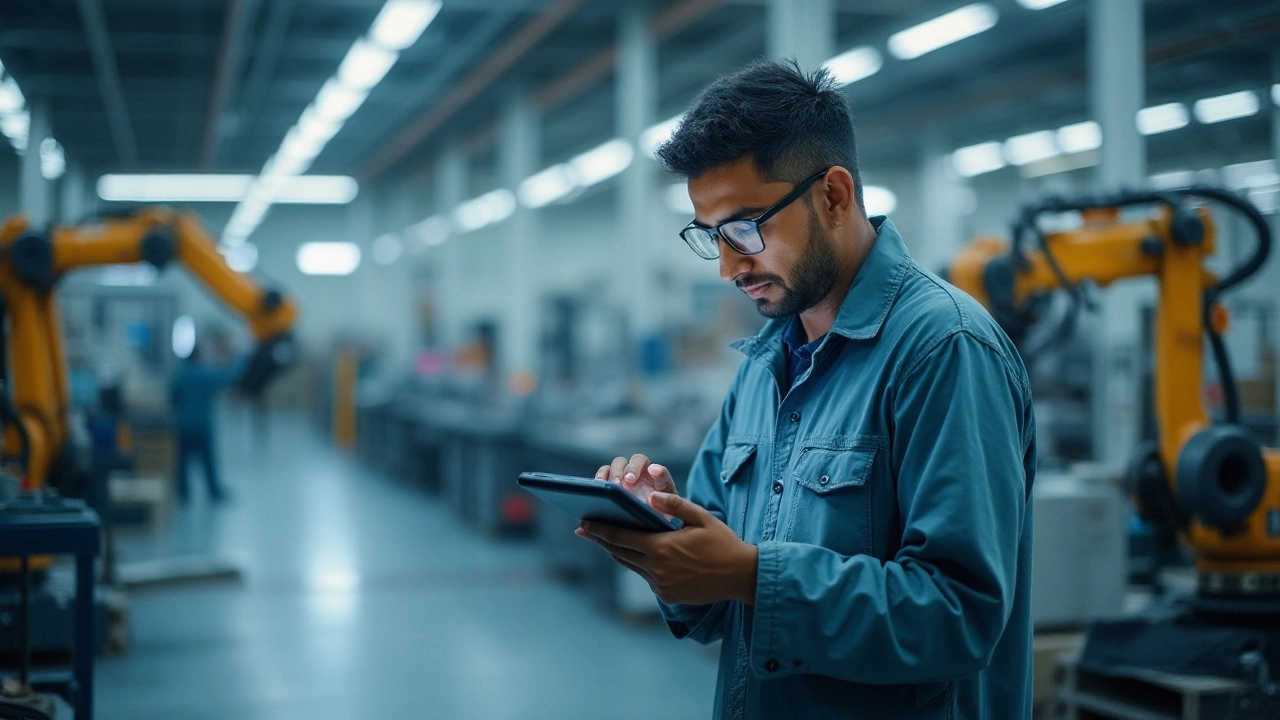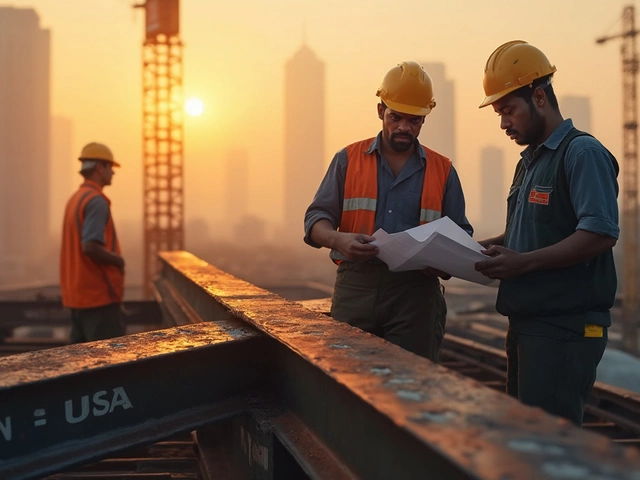
On the cusp of a new year, one subject of intense debate remains: Is America truly deindustrializing? This notion of shifting gears from manufacturing to a service-oriented society has sparked spirited discussions across boardrooms, factories, and dinner tables alike.
What compels this change? Is it the allure of technology and the digital revolution, or are deeper forces at play? As factories give way to tech startups, we witness an economic evolution where traditional manufacturing landscapes are reinvented.
Exploring this transformation helps us grasp not just what is being left behind, but the new structures and strategies the economy is building upon. As we dive into the intricacies of America’s economic metamorphosis, we uncover insights that illuminate the paths forward for industries, workers, and policy makers.
Historical Perspective
America's industrial journey is a saga of transformation that traces back to the throes of the Industrial Revolution. This era, spanning the late 18th to early 19th century, marked a profound shift from handcrafted goods to machine production, setting the stage for the powerhouse status the United States would achieve. Factories mushroomed across the nation, turning cities like Detroit, Pittsburgh, and Cleveland into bustling manufacturing hubs. This period was characterized by innovation, with inventions like the cotton gin and steam engine radically changing production dynamics.
As the 20th century dawned, America's manufacturing might reached its zenith during World War II. Factories pivoted to wartime production, churning out planes and tanks with relentless efficiency. The post-war era ushered in a golden age for American industry; the boom was fueled by a combination of technological advancements and a voracious consumer appetite both domestically and internationally. Yet, by the late 1970s, signs of decline began to surface. The emergence of global markets meant competition from countries like Japan and Germany was intensifying. These nations had invested heavily in modernizing their manufacturing capabilities, offering high-quality goods at competitive prices. Deindustrialization slowly crept in as industries began relocating jobs to regions where labor was cheaper.
In recognizing this gradual shift, a pivotal report from the Bureau of Labor Statistics in the early 1980s highlighted, "American manufacturing is no longer the dominant force it once was." It was a stark acknowledgment of the changing economic landscape, underscoring the need for adaptation. Thought leaders began evaluating how this transition impacted not just the industrial sector but also society's fabric. As the service sector grew, debates about economic priorities emerged, and strategic adjustments became inevitable.
Throughout the latter half of the 20th century, technological innovation continued to disrupt traditional manufacturing. The rise of computing and automation redefined efficiency and productivity benchmarks. Factories that once required thousands of workers could now operate with a fraction of the human labor, leading to job displacement. However, this also pushed companies to rethink their models, blending technology with manufacturing to create new opportunities. Attempts to safeguard the US economy included initiatives like introducing tariffs or supporting re-skilling programs to equip the workforce for new roles in a tech-driven market.
In the contemporary landscape, reflecting on the historical perspective offers valuable lessons. From thriving factory towns to present-day service giants, America's economic journey illustrates a tale of resilience and reinvention. The intertwining of globalization and technological progress with economic policymaking has guided the nation's responses to these shifts. It's a testament to the perpetual balancing act that the United States navigates, constantly evolving while aiming to sustain its legacy of innovation and industrial strength.

Global Influences
The concept of deindustrialization in America cannot be fully understood without considering the global influences at play. Over recent decades, the world has witnessed a significant shift in the balance of manufacturing power. Countries such as China and India have emerged as manufacturing behemoths, largely due to their ability to offer lower labor costs and less stringent regulatory environments. This competitive edge has enticed numerous companies to either relocate their production facilities overseas or source components from international suppliers.
As globalization deepens, the interconnected nature of world economies has altered the way industries operate. Trade agreements, such as the North American Free Trade Agreement (NAFTA) and its successor, the United States-Mexico-Canada Agreement (USMCA), have facilitated cross-border commerce but also exposed American manufacturers to more intense competition from abroad. The reduction of trade barriers has enabled more efficient supply chains; however, it has also led some domestic industries to decline as cheaper imports flood the market, contributing to the perception of a declining US economy.
Another factor to consider is the role of multinational corporations, which increasingly prioritize maximizing shareholder returns over traditional geographical loyalties. By embracing an international production model, these companies can optimize operations and drive down costs, often resulting in the closure of local facilities. A 2023 report by the Wilson Center pointed out how "globalization has inexorably changed the footprint of international manufacturing," emphasizing that nations need to balance innovation with global interdependence. Despite these challenges, not all is bleak. Opportunities still exist for America's manufacturing sector to thrive, particularly in high-tech industries and through strategic government incentives and support.
Moreover, as supply chain resilience becomes a hot topic due to geopolitical tensions and recent disruptions like the COVID-19 pandemic, there's a renewed push to bring some production back to US soil. This reshoring trend could help reestablish a stronger manufacturing base, albeit in a changed, more tech-focused landscape. The challenge, then, lies in finding the equilibrium between benefiting from global dynamics while safeguarding local manufacturing sectors.

Technological Advancements
The heart of America’s economic shift away from traditional manufacturing beats strongest within the realm of technological advancements. The continuous evolution and widespread integration of technology across industries have been transformative, driving the nation steadily towards a service-oriented economy. Once reliant on human labor assemblies and manual operations, businesses now operate with advanced machinery and automated processes. Robotics and AI play pivotal roles on factory floors, enhancing productivity while reducing the reliance on a human workforce. Automation, though efficient, often raises concerns over job displacement, introducing the dual challenge of retraining the workforce to keep pace with these changes.
Moreover, the rapid development of the Internet of Things (IoT) and the proliferation of smart devices have unlocked new dimensions in manufacturing efficiency and consumer engagement. Factories now employ IoT technologies to monitor equipment performance real-time, minimize downtime, and optimize supply chains. This data-driven approach not only boosts productivity but also requires fewer human interventions, further propelling the transition towards a service economy. Emphasizing quality control through smart technology has fostered competitive advantages for those who adapt quickly.
As technological prowess becomes synonymous with economic power, investment in research and development remains critical. The financial commitment towards innovation fuels this transition, with the United States consistently ranking at the forefront of technological research globally. According to a report by the World Bank, America spends a significant portion of its GDP on research and development, ranking high among developed nations. This dedication to innovation aids in maintaining global competitiveness, proving essential in a landscape where adaptability and foresight are valued more than ever.
"The rise of technology is reshaping our world in unimaginable ways, offering opportunities alongside challenges," says Elon Musk, CEO of Tesla and SpaceX, echoing the dichotomy of technological expansion.
These advancements have also enabled new business models, with digital platforms forming the backbone of many modern enterprises. The boom in e-commerce during the COVID-19 pandemic underscores this shift, as traditional retail operations had to pivot online to remain survivable. Companies that innovate and adapt their services to meet new technological norms reap tangible benefits, epitomized by the exponential growth seen in sectors like software, renewable energy, and fintech. Ultimately, the era of technological advancement underscores the need for a resilient and dynamism-infused economy, where understanding and evolving with tech trends is not just advantageous but necessary for survival.

Future Implications
The transition of America’s economy from manufacturing to services brings with it both challenges and opportunities. As industries evolve, we may witness changes that reshape societal and economic landscapes. One potential implication of this shift is the need for a workforce that is more adaptable and tech-savvy. As traditional factory jobs decline, new roles in the service and tech industries emerge, demanding new skills and competencies. This serves as a clarion call for educational institutions to pivot their curriculums toward a more technology-oriented and interdisciplinary approach, preparing students for careers in burgeoning fields.
Beyond the workforce, the shifting economic focus could reshape American cities. As industries change, we might see cities historically tied to manufacturing — like Detroit and Pittsburgh — continuing their remarkable transformations into hubs of technology and innovation. This aligns with efforts by city planners and entrepreneurs who see an opportunity to revitalize urban areas by attracting startups and tech companies. Such changes could spur growth in real estate, public transportation, and local businesses, creating vibrant and diverse communities.
The transformation also has environmental implications. With less emphasis on heavy manufacturing, which traditionally leads to higher emissions, there could be a positive impact on the environment. The service sector, particularly tech, tends to consume fewer resources and produce less waste compared to traditional manufacturing processes. This opens doors for sustainable business practices and innovations. Recent studies have shown that digital services can significantly reduce carbon footprints when replacing traditional industrial methods.
International trade relationships could also shift as America focuses more on services. With the decline of manufacturing, the country might import more goods while exporting services, intellectual property, and digital content. This may alter trade balances and diplomatic relationships. According to a 2022 report by the International Trade Administration, U.S. service exports have consistently increased, cementing America's status as a leader in the global service economy. A strategist at a recent economic forum remarked,
"America's strength has always been its ability to innovate and lead. As manufacturing transforms, it is crucial that we remain at the forefront of the digital and service revolution."
Ultimately, while deindustrialization shifts the economic landscape, it can invigorate new opportunities for growth and innovation if leveraged successfully. The key lies in how well industries, policies, and the workforce can adapt to change. By supporting a culture of continuous learning and innovation, America can not just manage this transition but turn it into an advantageous stride towards sustained economic growth.




